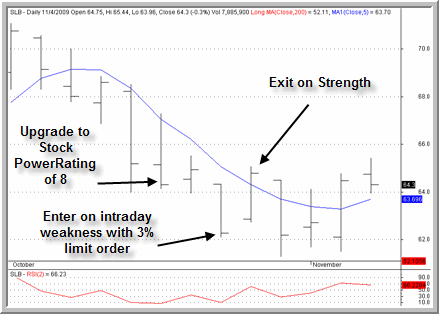Pullbacks, Intraday Weakness and the New Year’s 2010 Swing Trading College VIII
In yesterday’s report, I talked about the importance of pullbacks for swing traders.
Click here to read: New Year’s 2010 Swing Trading College: New Research, New Strategies.
Almost all swing trading strategies are based on pullbacks to one degree or another. However, many if not most trading strategies developed for swing traders have a tendency to wait for the market — whether that market is stocks or exchange-traded funds (ETFs) — to show upside BEFORE the strategy calls for taking a position.
Our research into short term market behavior for stocks and ETFs suggests that this can cause short term traders to miss making the most out of what the pullback provides: namely, the opportunity to buy a market when it is cheap and under-appreciated.
Imagine buying a long-desired item from the store. The item was on sale. But you are nervous about buying the item, so instead of buying the merchandise on sale, you wait for the merchant to remove the sale sign and, as soon as the sale sign disappears, there you are, cash in hand. Ready to buy.
Strange as this may sound, this is how many swing traders approach short term trading of stocks and ETFs.
As I noted yesterday, our approach to swing trading calls for buying stocks and ETFs after they have pulled back, but before they begin moving higher. Our research shows that buying pullbacks — such as 5-day lows — outperforms buying breakouts — such as 5-day highs.
But there is another way for swing traders to make sure that they are taking positions as close to that sweet spot between when the stock or ETF is likely to have stopped falling and when the stock or ETF begins rising. We call this strategy: intraday weakness.
Our research shows that while buying pullbacks is good, waiting to buy after the market has shown additional weakness during the next trading session (intraday) is even better. As traders who participate in the New Year’s 2010 Swing Trading College VIII will learn, waiting for a market to move lower on an intraday basis after it has already pulled back is an excellent strategy to get the lowest possible entry as the stock or ETF “swings” from falling to rising, from being a market that traders are avoiding to a market that traders are running over each other to enter.

Figure 1. OfficeMax
(
OMX |
Quote |
Chart |
News |
PowerRating) developed a Stock PowerRating of 8 on October 27. A limit order of 3% below the October 27th close provided traders with an entry at 10.83 the next day. When OMX closed above its 5-day moving average three days later, this sample trade was up more than 5%.
How can traders use intraday weakness as a short term trading strategy for increasing their edges and getting even better entries? Again, this will be a major topic of the upcoming Swing Trading College (click here to register for the free presentation and introduction to the course). But in short, we have discovered that, for example when it comes to stocks, using limit orders of 3%, 5% or even 7% below the previous close is a straightforward strategy for catching those markets just before they reverse higher.
Won’t some stocks pull back, but then move higher without additional intraday weakness? Won’t using limit orders that far below the previous close — especially 7% – mean missing trades? The answer is yes. This strategy for swing trading stocks means that those stocks that make more shallow pullbacks — or more volatile, one-day retreats — will not be traded. But our research shows that those trades that take advantage of additional intraday weakness are the ones that, in the short term, tend to outperform those trades taken on the initial pullback alone.

Figure 2. Schlumberger
(
SLB |
Quote |
Chart |
News |
PowerRating) earned a Stock PowerRating upgrade to 8 in late October, closing at 64.30. Here, using the same modest 3% limit order, a trader would have been able to take a long position in the stock at 62.37, two days later. When SLB closed above its 5-day moving average the following day at 64.80, the trade had gained nearly 4%.
For more swing trading strategies and tips for both stocks and exchange-traded funds, be sure to register for Larry Connors’ free presentation and introduction to the New Year’s 2010 Swing Trading College VIII, Wednesday, December 2th at 4:30 p.m. Eastern. In addition to our main course of high probability stock and ETF trading instruction, this year’s Swing Trading College will feature new research and new strategies for trading stocks, ETFs, options, e-minis and more.
With a New Year right around the corner, why not resolve to make 2010 your best trading year yet? Click here to register for Larry Connors’ free presentation on New Year’s 2010 Swing Trading College VIII today.
David Penn is Editor in Chief at TradingMarkets.com.
